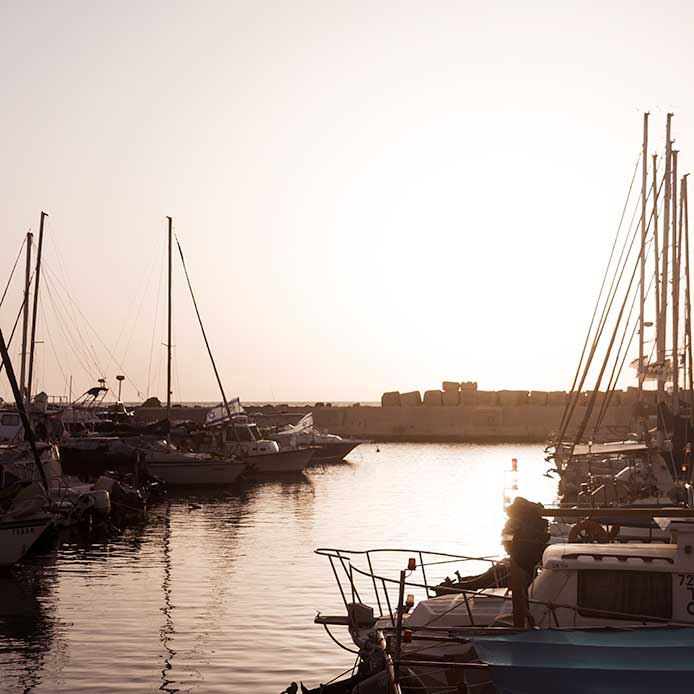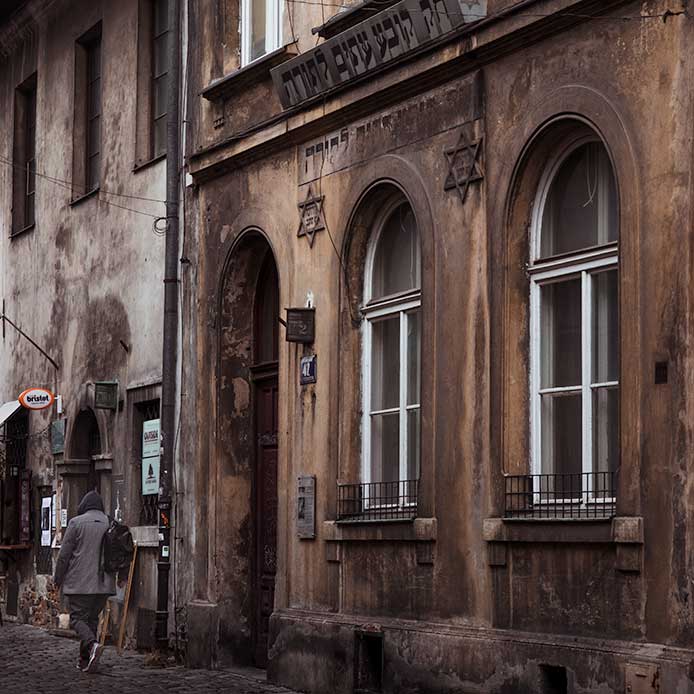
Far from the religious tensions in Jerusalem and the surfers crowd in posh Tel Aviv, a rebooted ruralism is kicking-off in Israel's southern half. Where the thread of Biblical and nomadic traditions was never entirely broken and where mass tourism never took root.
Israel's deep interior was often sidelined and forgotten. Luckily so. Wild places only remain wild when people mostly keep their hands off them. So one bright-skied morning in May, Kristof and I headed out to Midbara Cabins to experience the solitude and vastness of the Negev Desert.
Psssst, this post contains affiliate links. If you click one of them, we may receive a small commission at no extra cost to you.
The call of the Negev Desert: the ultimate Israeli desert road trip
In the southern part of Israel, one of the lowest places on earth, I'm enjoying a refreshing breakfast under the thatched roof of our desert cabin. Figs, fresh tuna salad, goat cheese, walnuts, and fresh fruit appear on the table, under the filtered light of the thatched overhang. A little further, palm and olive trees shade the snake winding path from our desert cabin to the main lodge. Under the shade of the trees, two dogs grown lazy from the heat, are patiently waiting for their own breakfast. A solitary speck of green surrounded by the rocky slopes of the nature reserve which encloses the Midbara property.
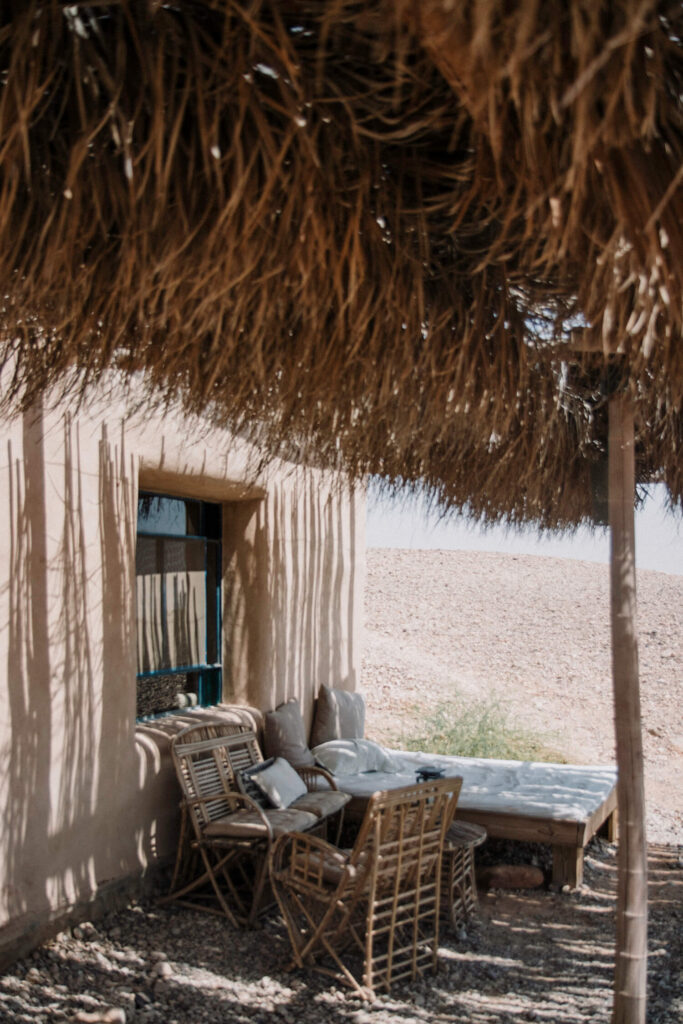
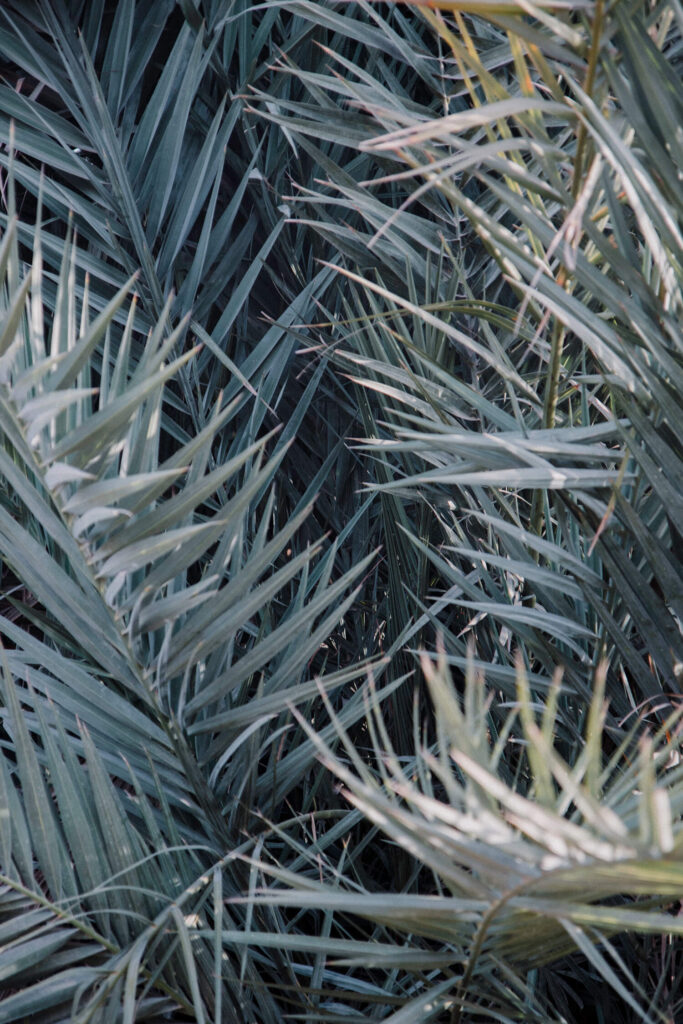
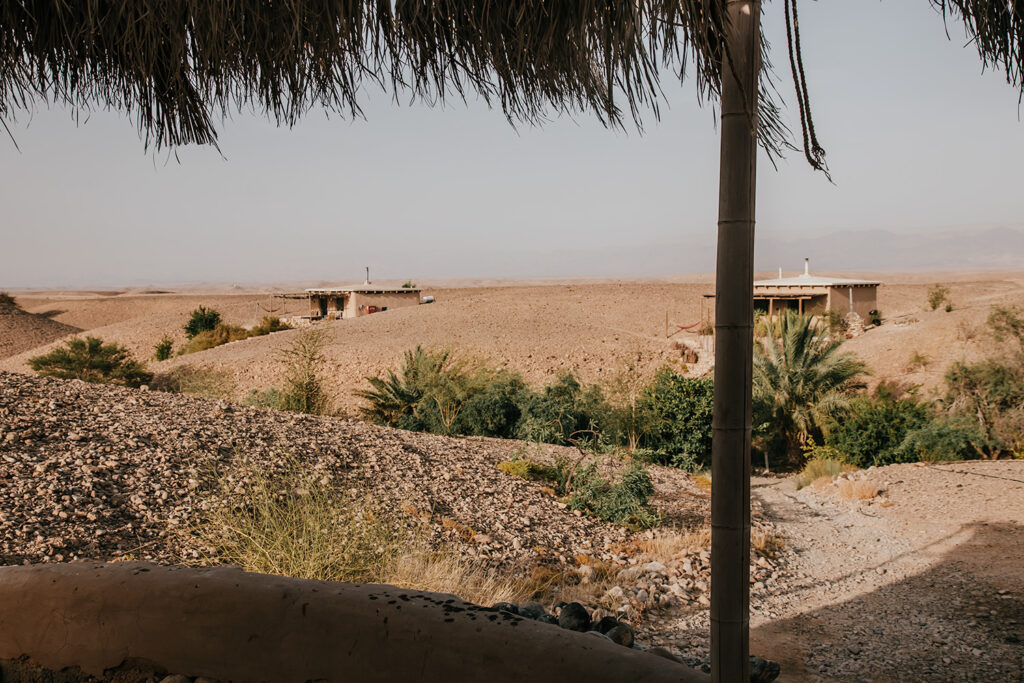
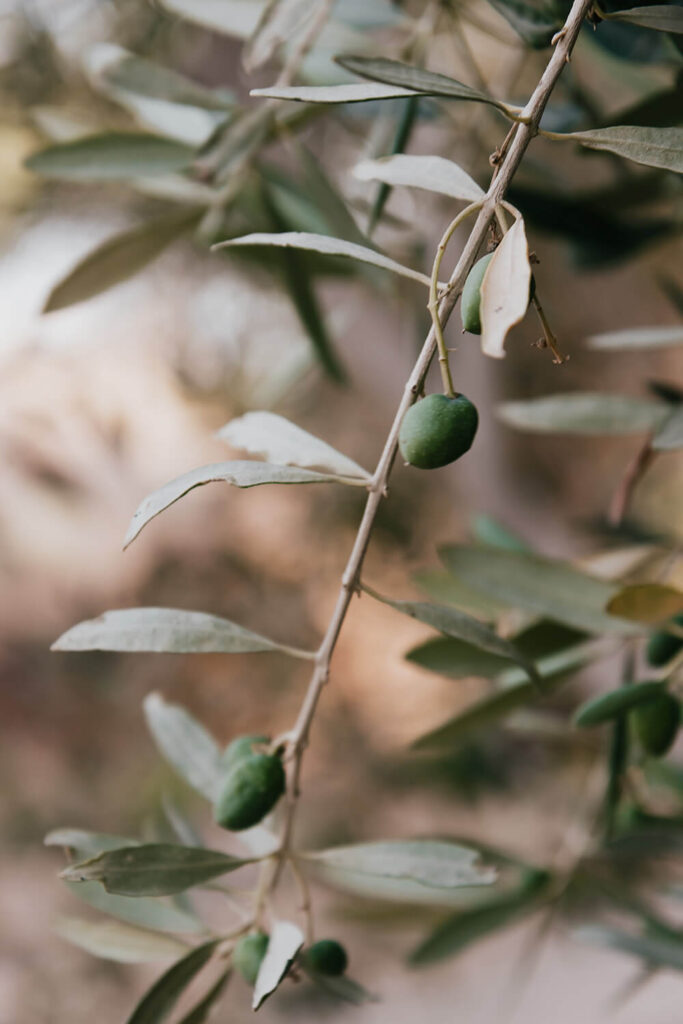
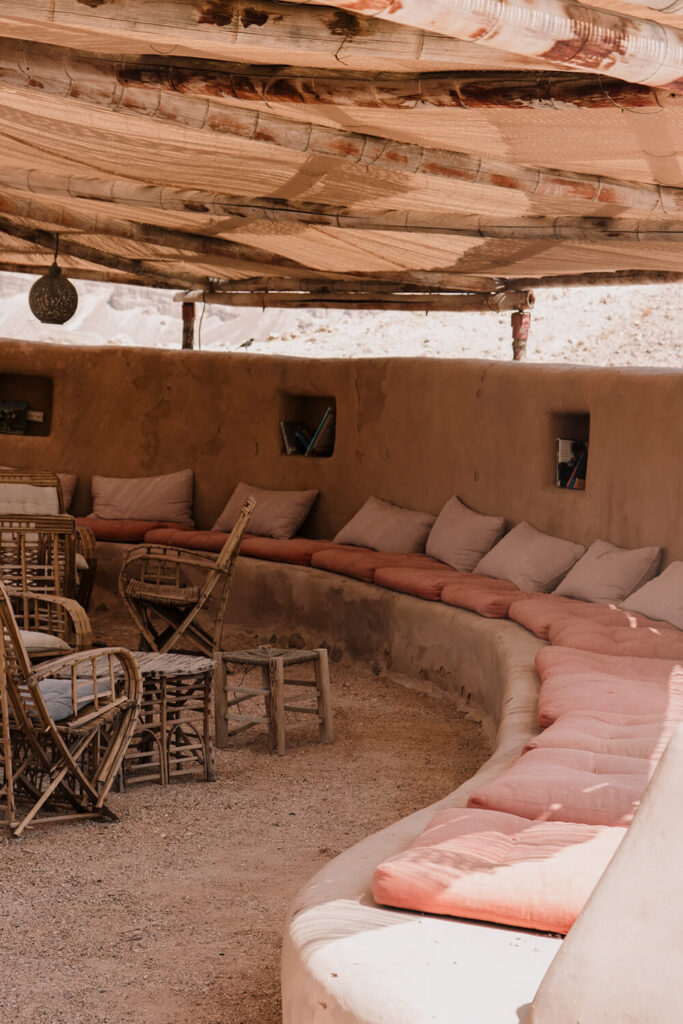
The rugged temperament of Nachal Ashosh (River Ashosh Reserve)
Wandering around these ancient lands in mute content, I savour the raw beauty of rocks and sand. Midbara Cabins is located in the River Ashosh Reserve on the eastern edge of the Negev Desert, near the border with Jordan. Perched atop the Reserve's rocky hills, we peer right into the dry river bed below from our cabin's private plunge pool.
The sweltering desert heat had us mastering the art of doing nothing. But when the sun starts to head down towards the tops of the rocky peaks and the air starts to swell with the sweet dusty scent of night, it is time to head out and explore our mind blowing backyard.
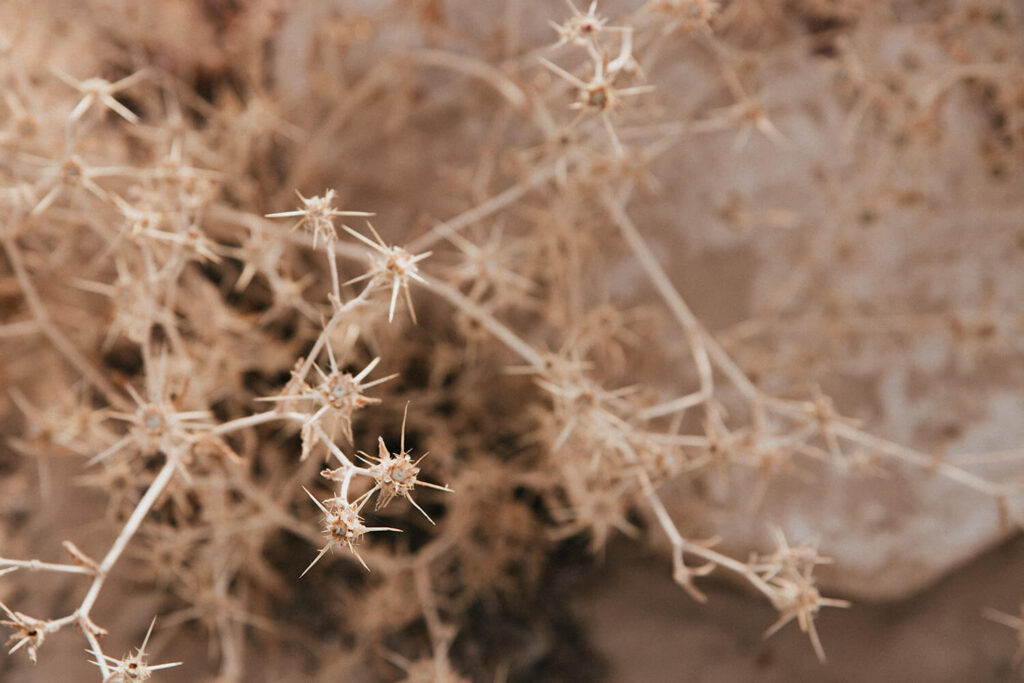
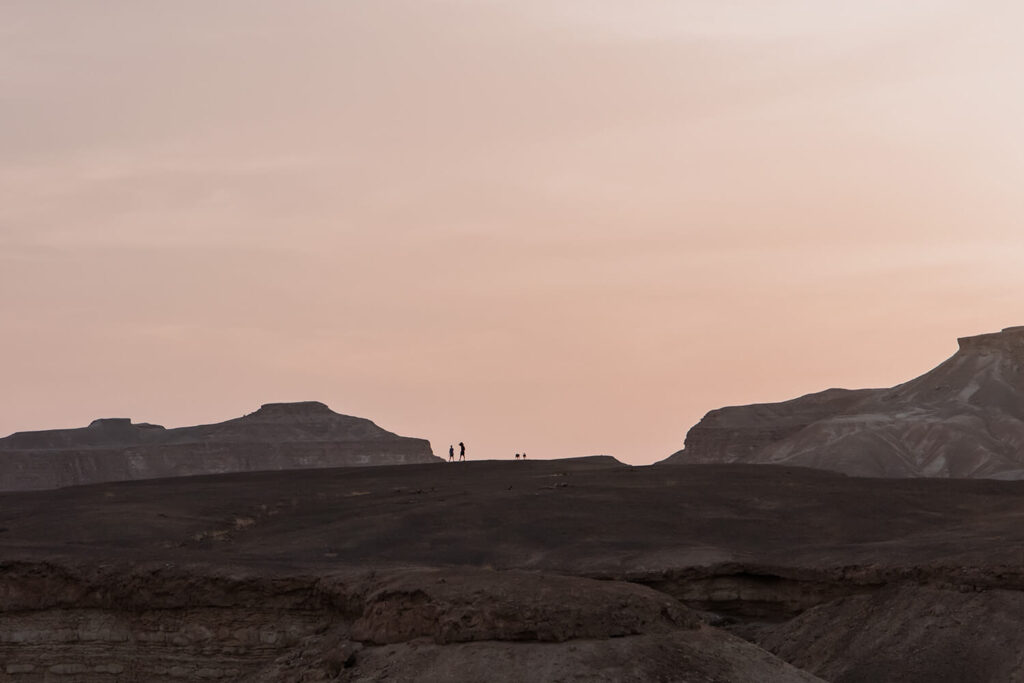
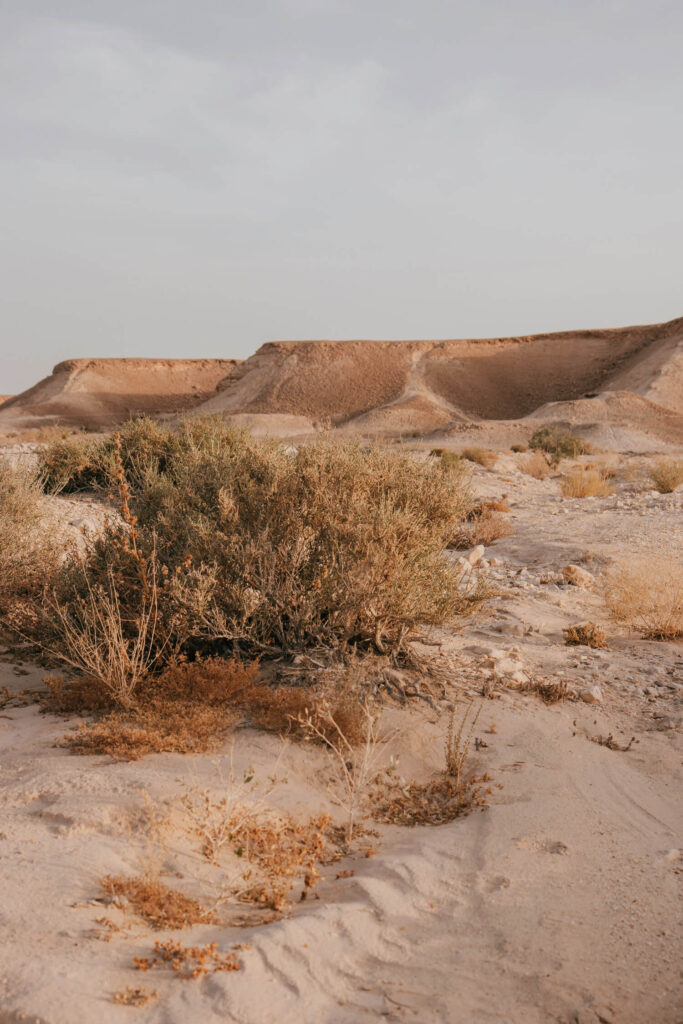
I don on my daypack and together Kristof and I head towards the purple coloured sandstone spectacle. Ant-like shapes can be seen passing sharp ridges against the light pink sky.
Different hiking trails crisscross the dry river bed, but we choose to wander until the setting sun dips too low for us to continue. The fluttering terra-cotta sand finding its way between our toes and clinging to our damp bodies. The raw, untouched beauty of this undoubtedly ancient land lets my imagination form wild stories of bygone times and tribes. The magic of this place only enforced by the twinkling stars and the sparks of our romantic sunset bonfire.
"I think having land and not ruining it is the most beautiful art anybody could ever want to own."
- Andy Warhol

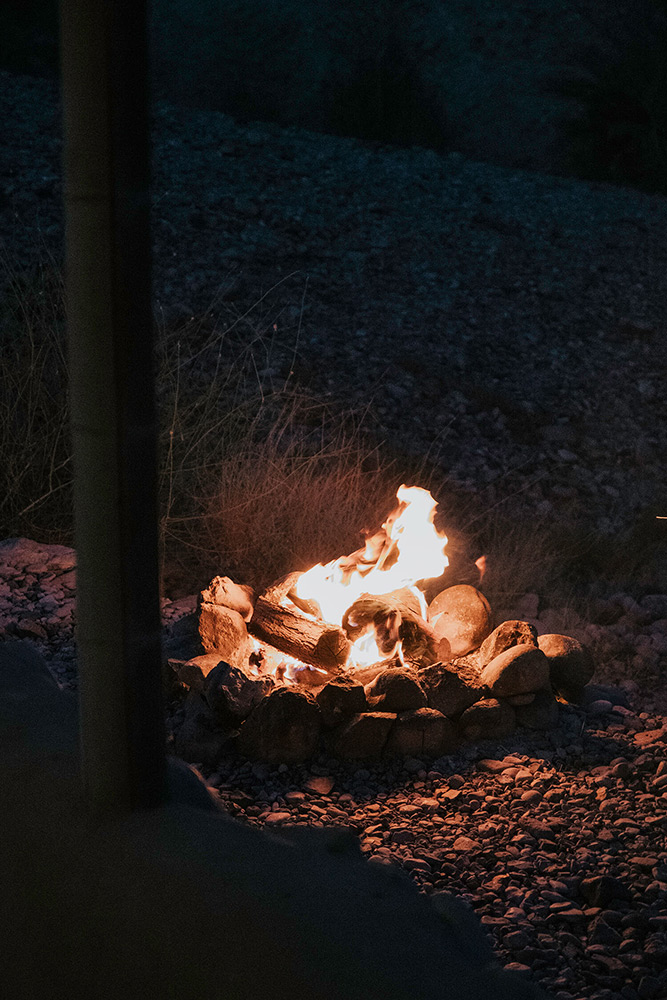
Crusade in sneakers to Masada Fortress
My phone ticks over to 4:30 a.m. and the sound of the alarm abruptly tares me from my whimsical dreams. Kristof and I set off through the empty roads of Israel's desert highway in search of the country's most spectacular viewpoint: Masada.
Our second day in this glorious sandstone jungle dawns beneath a cloak of twinkling stars and the glimmer of a full moon. Having been overwhelmed by the heath the previous day, Kristof and I intent on enjoying our trip to Masada in the tranquility of sunrise without the crowds and temperatures of midday. Arriving at our destination, the soft purple light of dawn is just beginning to wash across the desert badlands, stirring the almost unearthly stillness with the pleasant twitter of birds.
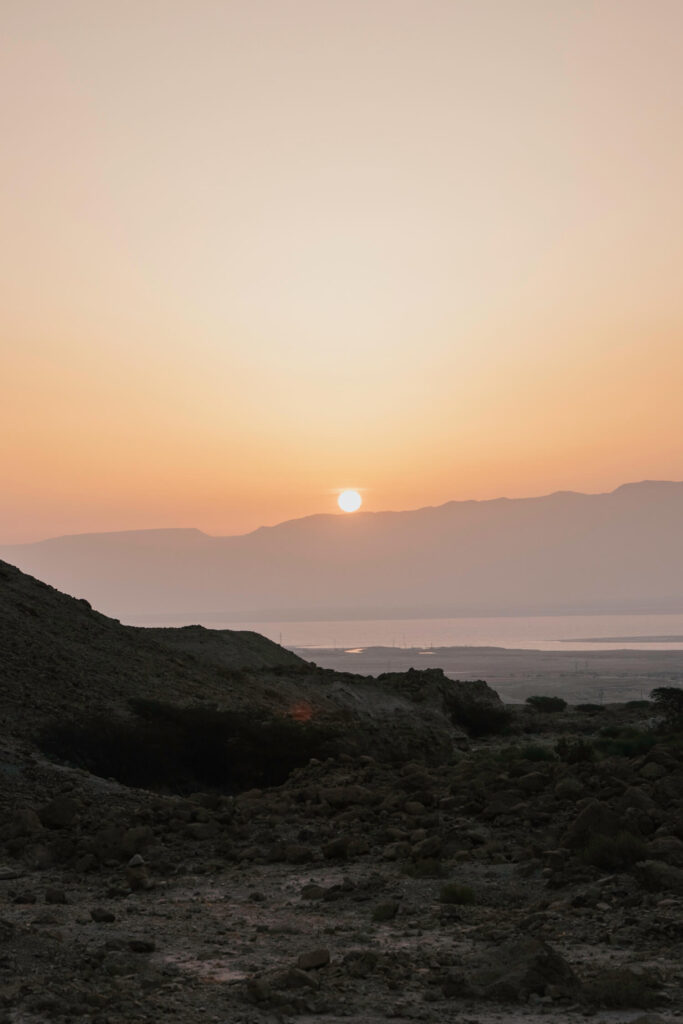
Ready to ascend the Masada Fortress, I look up to see the imposing sandstone mesa towering overhead. Still cloaked in darkness, I glimpse a sporadically interrupted trail of twinkling flashlights snaking slowly up the rocky plateau. Other hikers are climbing an ancient route zigzagging across the sheer plateau walls. Just as the sun starts to show, the east-facing wall illuminates and I get to see the winding path that will lead me to the viewpoint far above: the Snake Path.
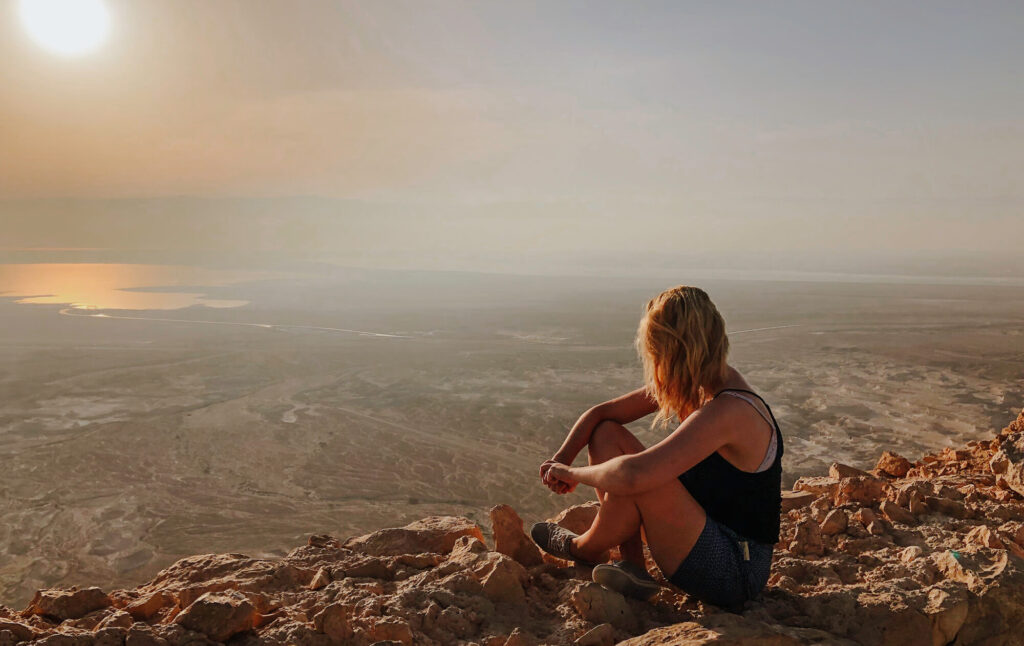
It's hardly daybreak but the oppressive heath is already sending beads of salty sweat down by spine. After an hour of trekking uphill, we make it to Masada Fortress in time for sunrise. A band of glowing copper sun rays slowly creeps over the valley below.
I find myself a seat amongst the ancient ruin walls and bear witness to the tremendous show nature decides to display before my eyes. In an hour or two, these ruins will be crawling with visitors trying to get the best possible view and facing rapidly increasing temperatures.
But for now all is calm and quiet and I drink it all in for a moment longer. I can only imagine what it must have been like as a crusader to look out from the Fortress over the desert and Dead Sea below, several centuries ago. It’s safe to say, this is not a morning I’ll soon forget.


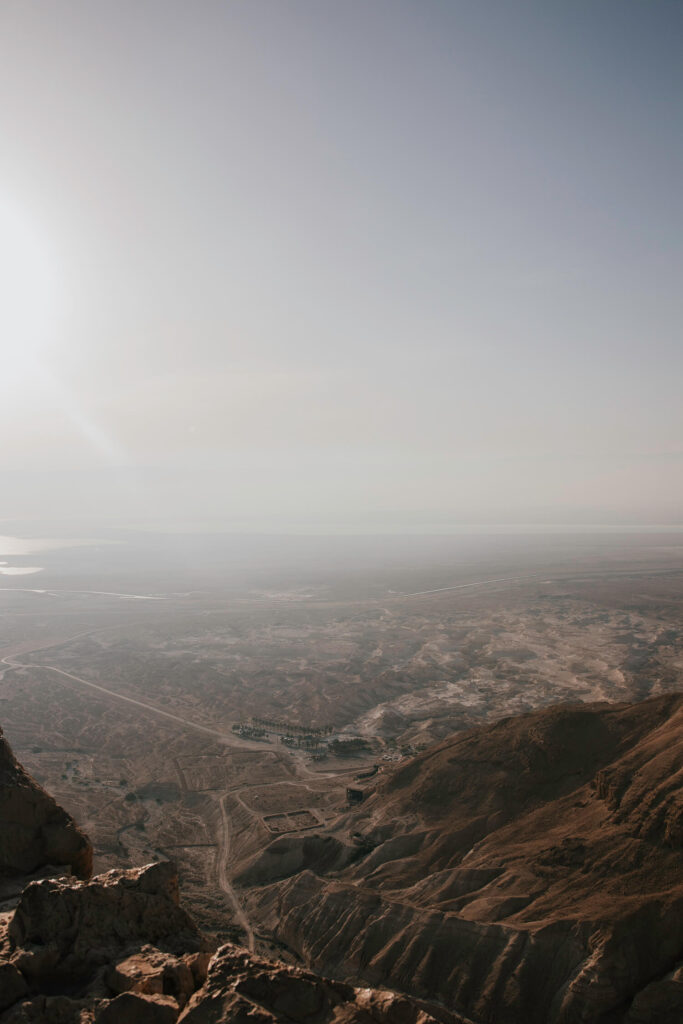
- Make It Happen -
Starting and Finish Point of the hike | take your car and drive up to Masada National Park eastern car park
Length of the hike | 2km (one way) - we did it in about 45minutes including photo stops and short snack breaks
Elevation gain | takes you up 349.9 meters in altitude (1,148 feet)
Best time to hike | start one hour before sunrise (summer, start hiking at 5am) - temperatures are still cool, it was about 22°C when we did the hike
Opening hours | the Snake Path opens to hikers as from 1 hour before sunrise. During winter times, you can start the hike until 9am, in summer times it is possible until 8am due to the heath.
Entry fee | 28 NIS (per adult) for the hiking trail and a one-way cable car ride (starting at 8am) cost 29 NIS if you don't fancy walking back down.
Walking on the moon in Mitzpe Ramon (Ramon Crater)
The drive back to our home away from home is spend in absolute stillness, both of us still reveling in the amazing sights we witnessed an hour before. The adrenaline rush of our sunset hike quickly waring off. The veil of reality once again clouding my previously sharp senses. I have to confess, I’m not at my best in the morning.
Tired but satisfied I walk up the rising path to our cabin. A bright red cool box with delicious breakfast is flauntingly waiting in the shade of our terrace as a ravenous feeling overwhelms me.
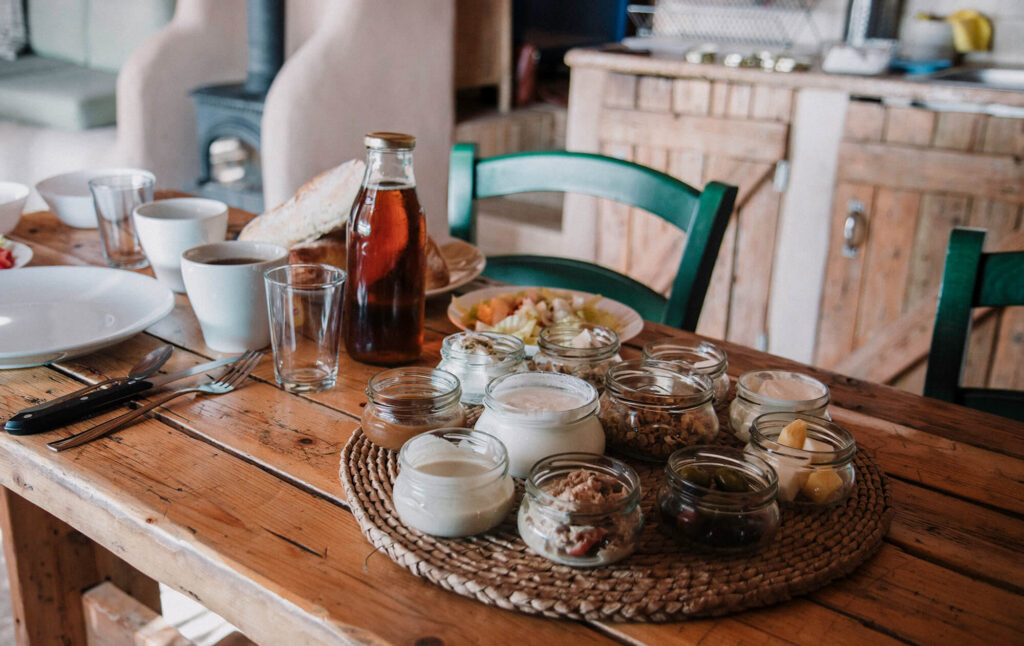
In Belgium, breakfast is always a simple affair - just a steaming black hot cup of coffee or tea, some toast and perhaps a bit of jam or chocolate spread. In Israel, the Israeli breakfast may consist of – but is certainly not limited to – various kinds of yogurt, labane (yogurt cheese), cottage cheese, freshly-pressed juices, salads made with any combination of tomatoes, cucumbers, herbs and olive oil, salty olives, tuna salad and flat breads. In Israel, breakfast is a feast.
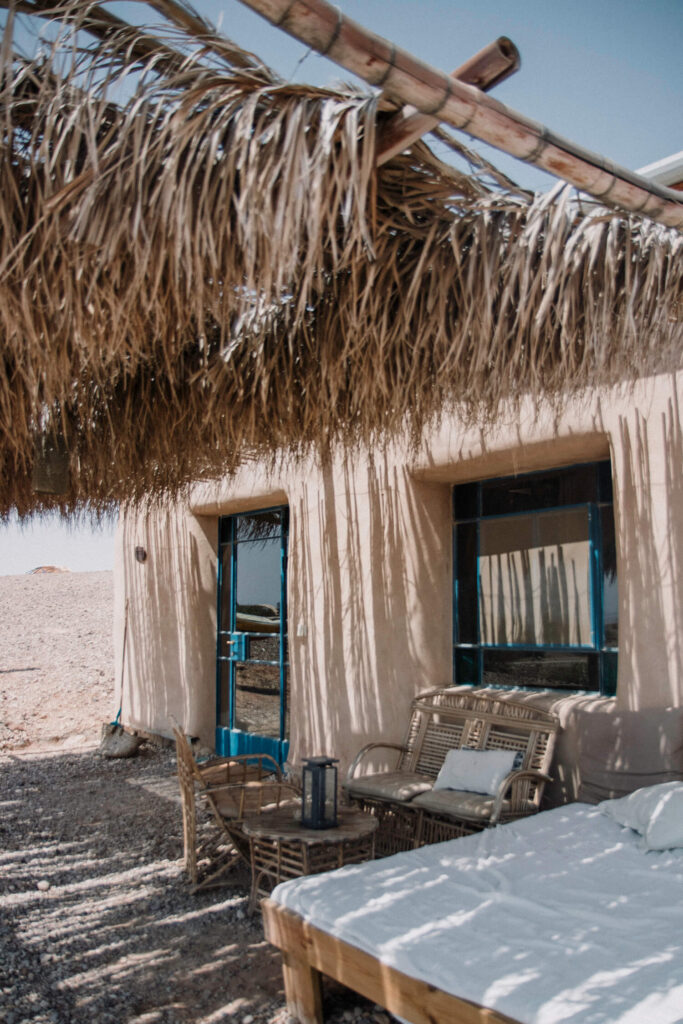
It's only 10 o'clock in the morning. For the other travelers at Midbara, a new day begins. The dogs are back sunbathing on the path and a rusty jeep with supplies for the lodge runs past our cabin. It could be any typical morning here in the desert. But for us it's a day of extremes. The warm and sunlit town of Mitzpe Ramon is only an hour away from Midbara. The rugged landscape of the Negev Desert is a haven for one of the most spectacular landscapes in Israel: the Ramon Crater. To appreciate the Ramon Crater you'll need to desert the beaten path. Many people drive through the deep crater on their way to another destination, but few take the time to explore its secluded trails.
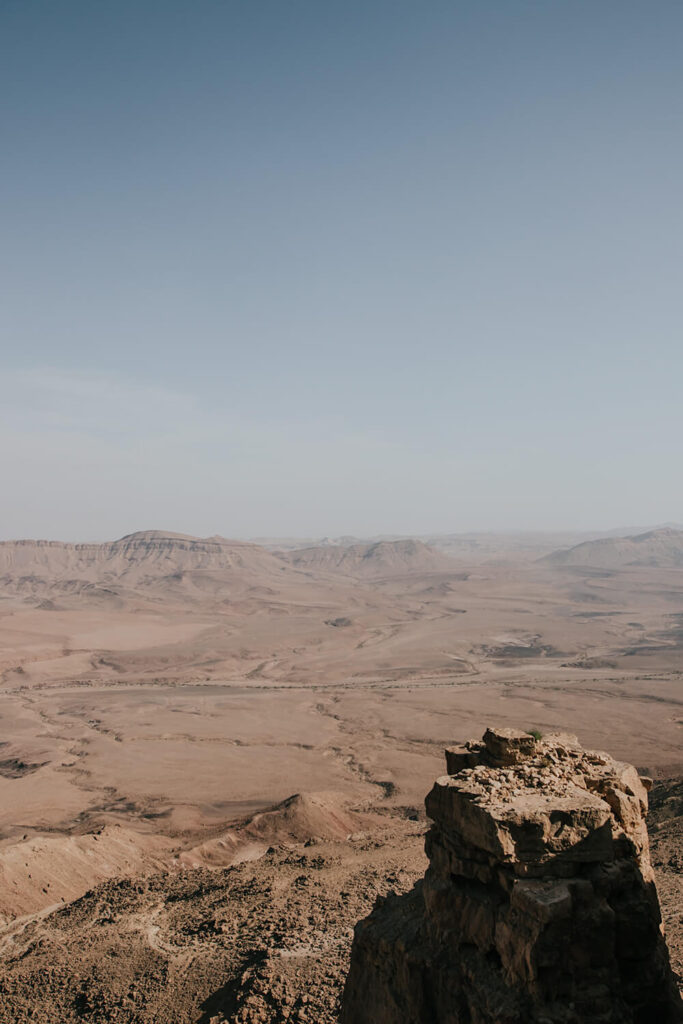
Nicknamed Israel's Grand Canyon, the Ramon Crater is anything but unimpressive. The sheer size alone has me gasping for air as I take it all in. How can tiny Israel have such a gigantic secret? But word is slowly spreading about Maktesh Ramon, the vast lunar landscape hidden in the heart of the Negev Desert.
"Discover in the heart of the Negev Desert an ancient crater, often nicknamed the Grand Canyon of the Middle East."

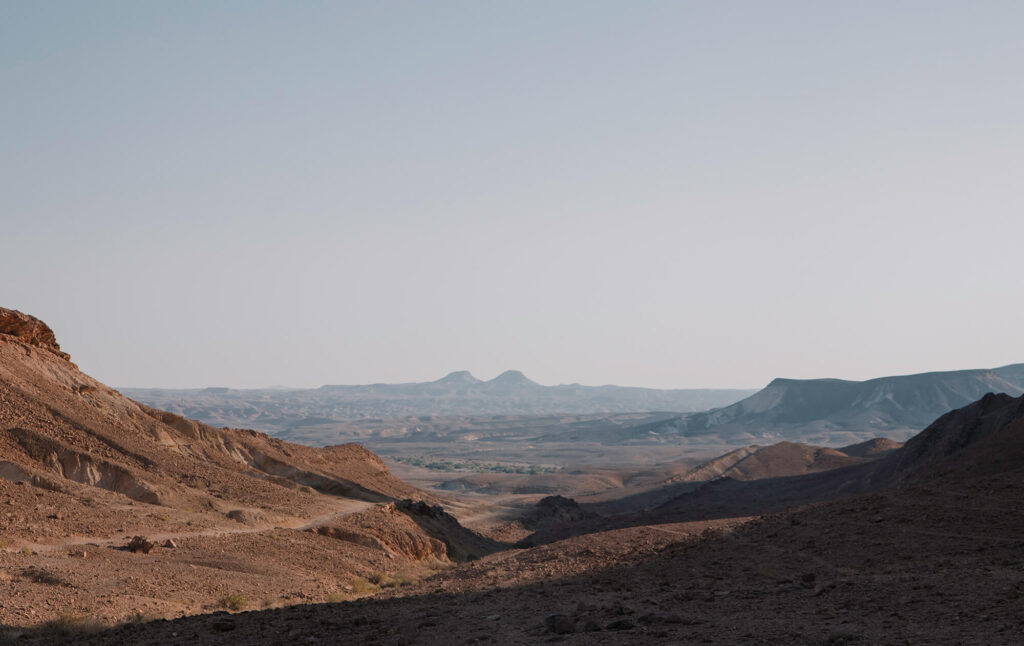
I'm under the influence of this world, dizzy by its ethereal beauty, enormity and its rare stillness. My hearing slowly adapted at the silence of the desert and I hear a soft sound. The wind slowly rustling the twisted, shrubby branches of small bushes and the distant screech of a Buzzard. From the crater wall I see the hiking trails that we just explored, slowly shrouding themselves in darkness. It is 6p.m. It has been a fine day. A very fine day.
- Make It Happen -
Entry fee | visiting the crater is free and perfectly doable with a normal car.
Starting and Finish Point of the hike | Highway 40 - Ammonite Wall sign
Duration of the hike | 3km (round trip), about 1,5 hoursBest time to hike | early morning or afternoon (try to avoid the midday heat especially between May-September.
Ramon Crater viewpoint | Behind the visitor's center you can leisurely stroll along the crater rim. Watch out though, part of the walk is not fenced nor any other safety measures are taken. It's a sheer drop to the bottom so keep kids (and overly excited husbands) in tow!
Travel Tip | Keen on venturing deeper into the Ramon Crater? Desert Eco Tours come highly recommended, especially for their trip into Wadi Rim/Zim Valley.
Coming to life at the Dead Sea
Sunrise lingers briefly on the tops of the River Ashosh Reserve and casts golden rays on the Midbara Lodge while the valley below is engulfed by shadow. I hesitantly bid goodbye to our tranquil desert cabin and know it is time to say farewell to the landscape I find myself at home. I appreciate its simplicity, its imperfections and understated elegance. Midbara Cabins is not our the most exclusive or most expensive stay, but it certainly is our most memorable.
On the way to our last stop in the desert, before entering the holy city of Jerusalem, we're traveling past No Man's Land: regions between Israel and Jordan which are marked as "disputed territory". The area is closed and nobody is allowed to cross the border. A sad relic of the years following the Second World War. Depending on whom you ask, it belongs to Israel or Jordan. At the time of our visit, the situation between Israel and Jordan remains stable but the relation with Palestine is still poignant.

Peace in the region may well be at an all time low, we find ourselves literally at an all time low at the Dead Sea, an extremely salty pool of water shared between Israel and Jordan.

I'm standing at the edge of the infamous salt water sea, my toes hurting at the sharpness of salt crystals I appear to be standing on. Treading carefully, I wade myself deeper into the body of water which incredibly oil-like. Though Kristof has already experienced a similar phenomenon in the Atacama Desert, it was a first time for me. A mind-boggling encounter between myself and the lowest point on the earth, 1,320 feet below sea level.

Slowly I let this force of nature win my trust and crouch down. Lay back. And miraculously float. Bobbing on the water surface, I see the salt crystals twinkling beneath me.
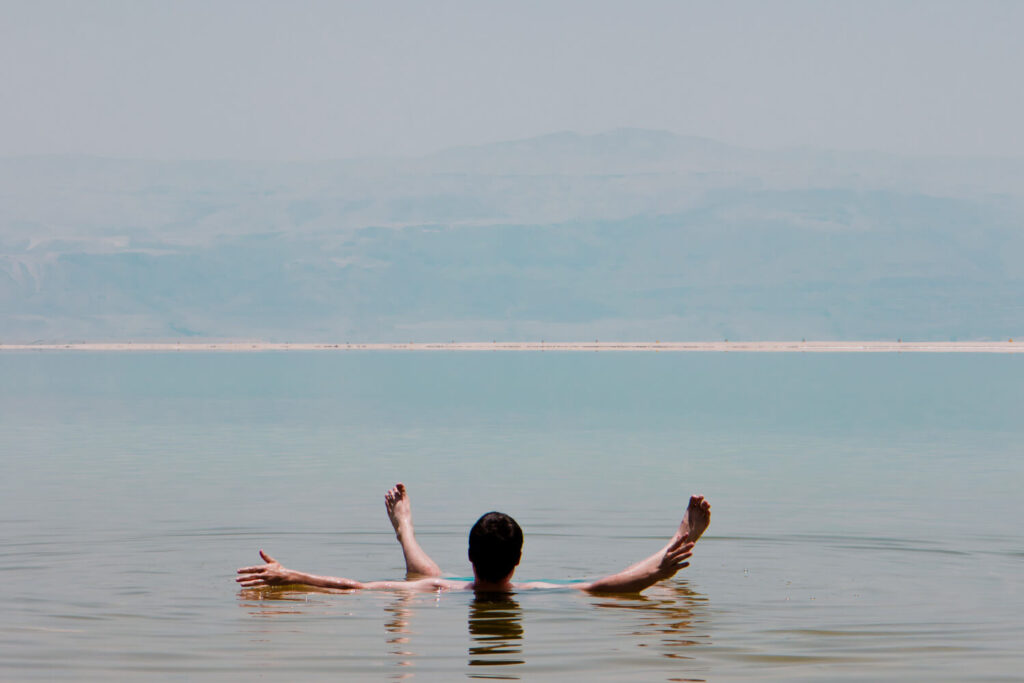
No matter how hard I try, I cannot seem to be able to grab deep enough in order to pick one up. The irony is not lost on me. The very properties causing the Dead Sea to be 'dead', are stopping me from doing anything that would potentially cause me my life.
A vastness of warm turquoise water surrounds me, like I am being swaddled with the softest baby blanket. The continuingly increasing temperatures reach 45 degrees Celsius and forcibly tear me away from my relaxing cocoon.
- Make It Happen -
Entry fee | Free if you visit one of the public beaches like Ein Bokek public beach.
Amenities at the beach | Showers, water fountains and shops with Dead Sea mud.
Our favourite beach | We ventures to Neve Zohar as the public beaches didn't really comply with my dream vision of the Dead Sea. In search for more salt pools and less Vegas vibes (the coastline does look like the Las Vegas strip with bling bling hotels) we ventured a bit further south. This area seemed more raw and had far less visitors.
As we leave the Dead Sea and the desert lands behind, the distant city of Jerusalem appears like a mirage before our eyes. While the sun slowly dips towards the horizon and the valleys and roads are cast in a blanket of shadows, the copper coloured landscape suddenly transforms in what it must have looked centuries ago.
But for now the Negev Desert is there as God (or the devil) has left it: a huge mass of sand, stone and an incredible history that has been influential to the entire world.
How to get to the Negev Desert from Tel Aviv
The Negev Desert, located just a mere few hours drive from Tel Aviv, Israel, is the kind of raw and dusty paradise we were looking for when booking our tickets. If you’ve been following along here for any stretch of time, it’s no secret we love desert landscapes. Kristof and I have spent countless days exploring the Atacama Desert back on our Andes road trip in Chile, and it was exciting to finally experience the Negev Desert linked to so many religious and historic tales in Israel!
To get from Tel Aviv to the Negev Desert, or from Jerusalem for that matter, there are a few options. It all depends on what part of the Negev Desert you want to explore, it covers half of Israel after all.
By plane:
The newly opened Ramon International Airport Eilat has an hourly service from Tel Aviv and handles all flights coming to Eilat, the southernmost part of Israel near the Red Sea.
By bus:
From Tel Aviv or Jerusalem you can easily catch a bus to Be'er Sheva or Eilat. Towns and villages throughout the Negev are connected by bus to Be'er Sheva, but service could be infrequent. Try to book your bus ticket in advance in order to avoid having to stand the entire way there.
By car:
What some folks don’t realize is that there’s more to the Negev Desert than just Masada and the Dead Sea! It isn’t just a remote box of sand, there are roads. So, you can easily take a rental car from Tel Aviv directly to your destination in the Negev Desert and explore surrounding attractions from there, which is what we did.
Two highways for private vehicles cross the Negev from north to south:
- Route 90: The eastern Jordan Valley route from Jerusalem past the Dead Sea to Eilat.
- Route 40: The central route, through Be'er Sheva and Mitzpe Ramon (Israel's Grand Canyon), which will merge with the eastern route.
We suggest make a true Israeli desert road trip out of it and driving south on Highway 40 towards Eilat from Tel Aviv. The landscape becomes strikingly beautiful shortly south of S'de Boker (home and gravesite of David Ben-Gurion). This road actually runs right through the Makhtesh Ramon - Israel's 'Grand Canyon'. We took Route 90 on our way back to take in the sights near de Dead Sea. The infrastructure and roads are in excellent condition and even better than back home in Belgium.
Where to stay in the Negev Desert
Tucked away in the peaceful village of Zuqim, south of the Dead Sea, is Midbara Cabins. The beautiful boutique resort is located, together with 3 other resorts, right next to the Nachal Ashosh (River Ashosh) reserve and guarantees spectacular views!
We were seeking peace and quiet, a hammock, a private pool and vistas that would blow our socks off. Midbara Cabins was exactly what we needed!
This small family-run property has 13 handmade mud huts peppered throughout the desert landscape. Each mud hut is individually unique. Equipped with all modern amenities you need to enjoy your stay, most cabins also have a dumpling pool to cool off, a hot tub or chilly desert evenings, a barbecue and deck chairs to enjoy the most spectacular scenery and sunsets you'll ever experience.
Bonus: a traditional Israeli breakfast spread is delivered straight to your room for 60NIS per person.

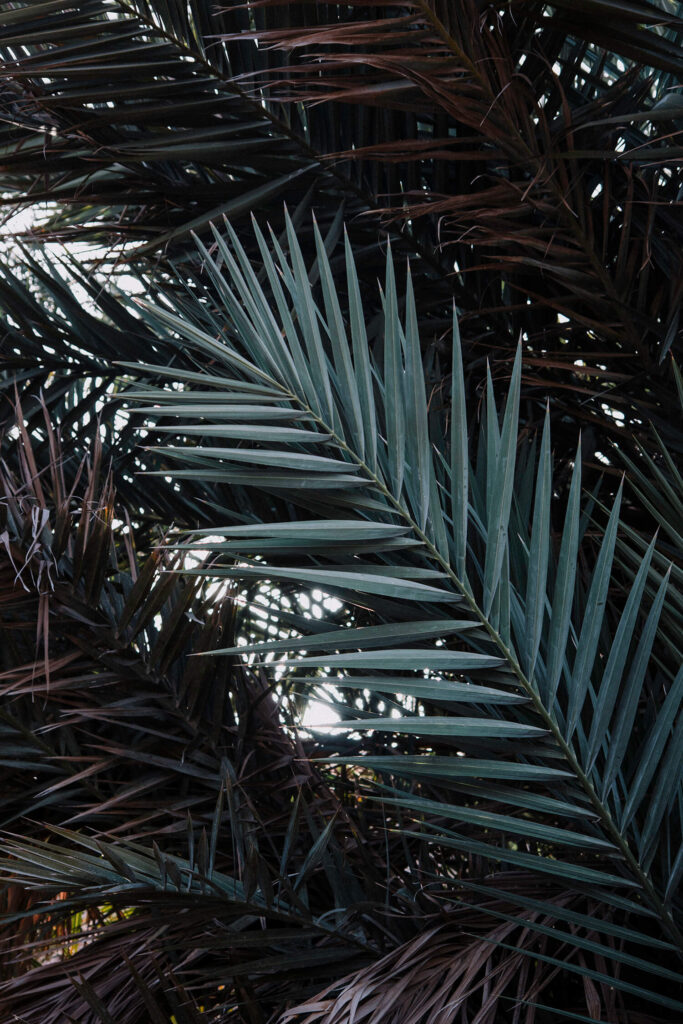
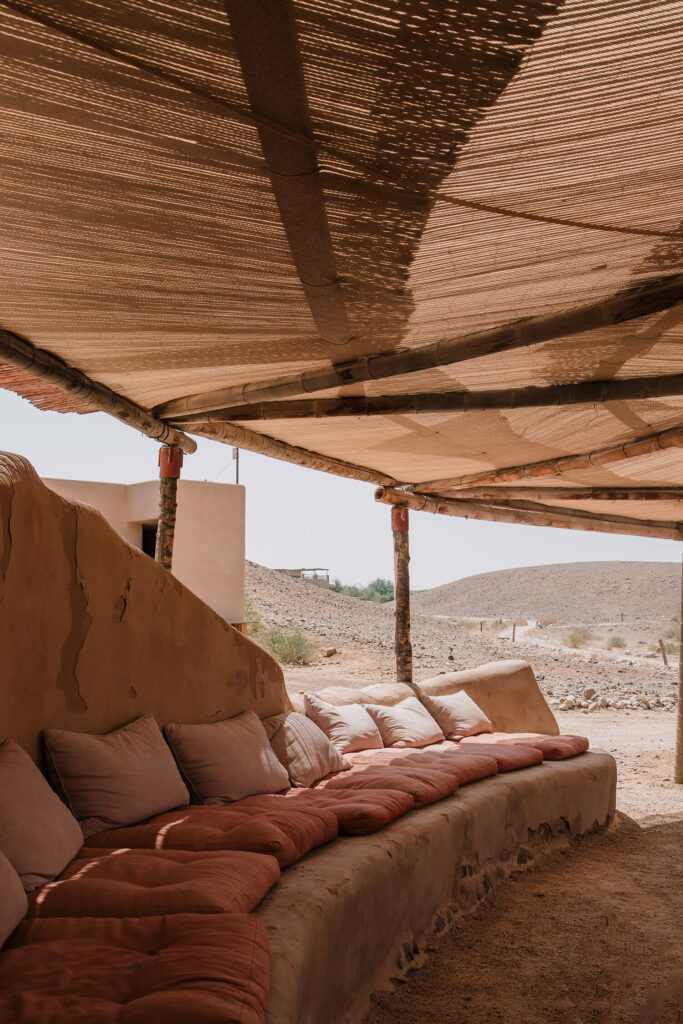
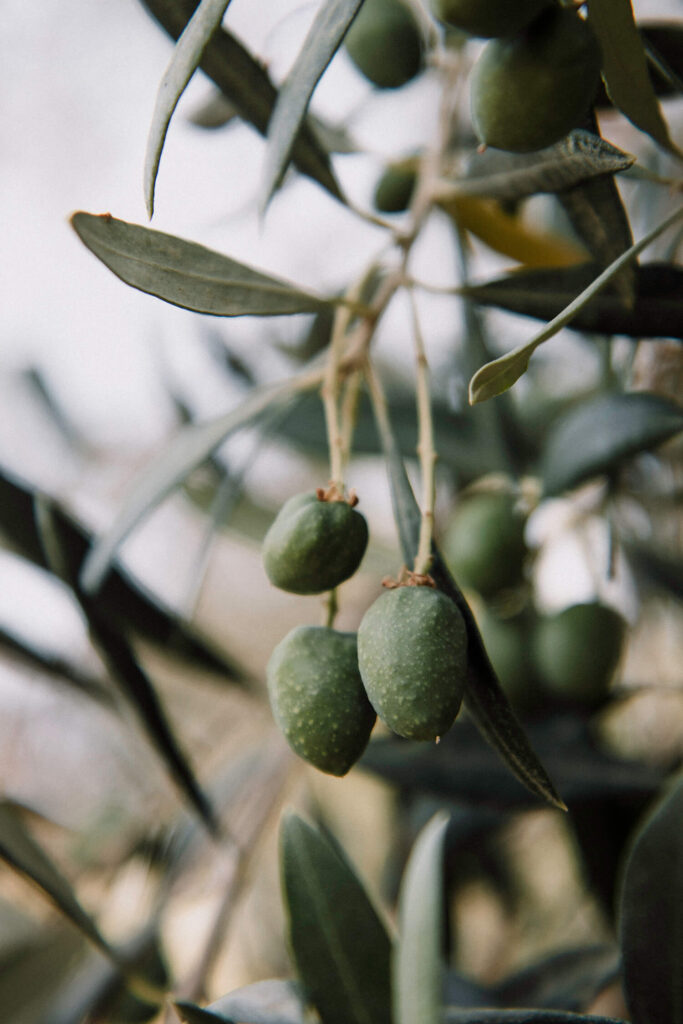
You can bring your own food, a fridge is provided in every cabin, but there’s also the honesty pantry. A pantry stocked with all amenities you need from wine and soft drinks to olive oil, pastas and sauces and snacks. Fancy a glass of wine and Israeli cheese platter while watching the sun drip behind the horizon? Check!
We highly recommend a stay at Midbara Cabins if you’re visiting the Negev Desert!
Dead Sea and Masada day tour vs. overnight stay in the Negev Desert?
If you’re short on time or just looking to spend the day floating in the Dead Sea, you might want to head to the southern part of the Dead Sea near Ein Bokek. A day tour to the Dead Sea and Masada, like this one, might be right up your alley!
Not venturing deeper into the Negev Desert might be a mistake though. To truly experience the remoteness and beauty, go glamping under the stars like we did at Midbara Cabins. Hook up a rental car in Tel Aviv for 3 days and explore the desert on your own!
Why wouldn’t we recommend one of the most popular day trips from Tel Aviv or Jerusalem? Well, because it is kinda rushed and touristy. We preferred to float into the Dead Sea on our own schedule and loved hiking the Snake Path up to Masada on our own pace.
So, bottom line? The best way to visit the Negev Desert is to stay overnight! By choosing to stay overnight in the Negev Desert, you can still support the local economy and you can can do it at your own leisure. That's a win/win guys!
What to pack for a trip to the Negev Desert?
Now that you’re all ready to hit the road into Israel's most beautiful piece of nature, what are you going to pack for the Negev Desert? No worries, we got you! Here’s a quick summary of the most important things to bring to the Negev Desert.
- Stainless Steel Insulated Water Bottle: You'll be headed into a desert in the Middle East. Being hydrated wil be your top priority! Stainless steel reusable water bottles are a perfect item to take with you. Israel has drinkable water everywhere and you can find water fountains sprinkled throughout various attractions (yes, even in the desert) which make it super easy and cheap to refill your water bottle.
- Reef-Safe Sunscreen: If you plan on floating into the Dead Sea, you'll definitely need sun protection. We always wear reef-safe biodegradable sunscreen when we go swimming or snorkeling. Even though life in the Dead Sea is, you know.... dead, we prefer not to bring any extra harmful stuff into the water. Here’s a full-sized bottle and here’s a travel sized care pack for carry-on luggage.
- Full-Sized Microfiber Beach Towel: This is a must when you're heading to the Dead Sea. Nothing is more horrible than finding out you haven't brought a towel on your travels when you're at the beach. This awesome travel towel is pretty and oversized, meaning it's super comfortable to sit in (aka not getting your butt in the sand) and weighs next to nothing. It rolls up small into a zipper bag and dries quickly so you’re not lugging around a heavy wet towel all day.
- Bug Repellent: This is our favorite bug repellent! It’s organic, it smells nice, is incredibly effective and doesn’t make a greasy mess when you apply it. Small bugs fly around at the Dead Sea's shores and in the desert sand.
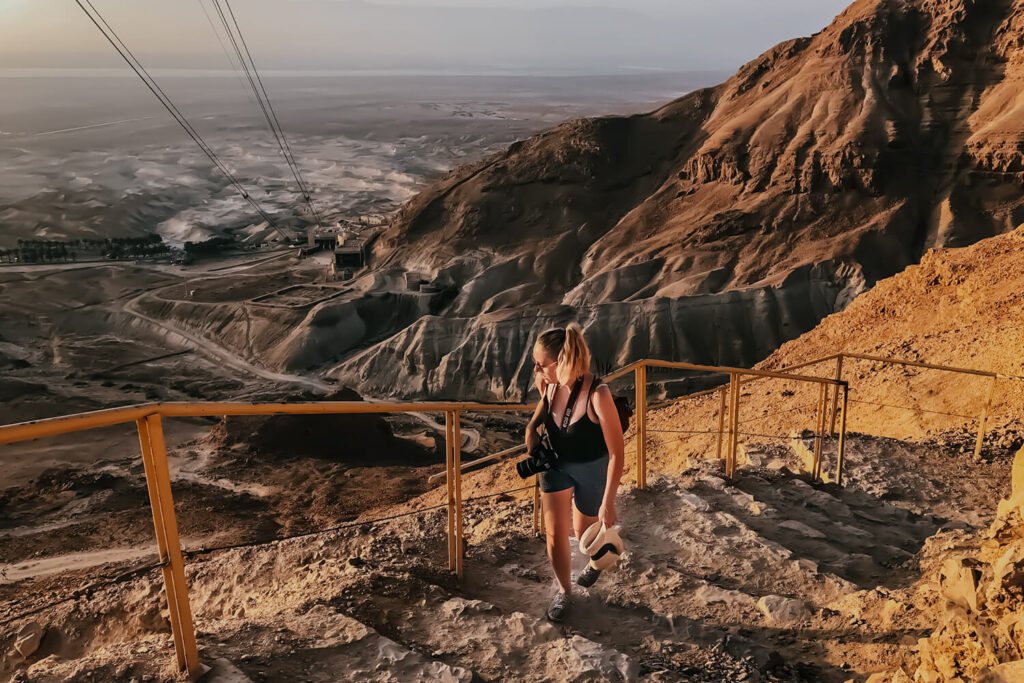
- A bathing suit you don't care that much about: the salt in the Dead Sea might cause some discoloring so better to choose a bathing suit that you're not that fond of. However, do bring your favorite swim suit if you want cool off in your private pool at Midbara Cabins.
- A cute hat: staying in the desert means spending lots of time in the sunshine. I could not imagine not having my boater hat with me, it was such a life saver! Unfortunately I get frequent headaches because of direct sunlight on my head so I NEVER travel without a cute hat.
- Lightweight breathable clothes: You'll probably have noticed Kristof and I are not the most fashionable people around the world wide web. We're all about comfort and try to find clothing items that are practical, durable and also look at least semi cute! My favorite pieces of travel clothing right now are my L Space Andes Pants (they're breathable, stylish and come in different colors), these linen shorts and striped tie shorts, my Teva sandels for when I'm out exploring and my stylish babouches for a leisurely evening or restaurant visit. Lastly, you will probably want a pair of casual shoes that can be worn for anytime you need something closed-toe (e.g. when you go hiking), like the Adidas Swift Run Shoe.

LOVE IT? PIN IT!

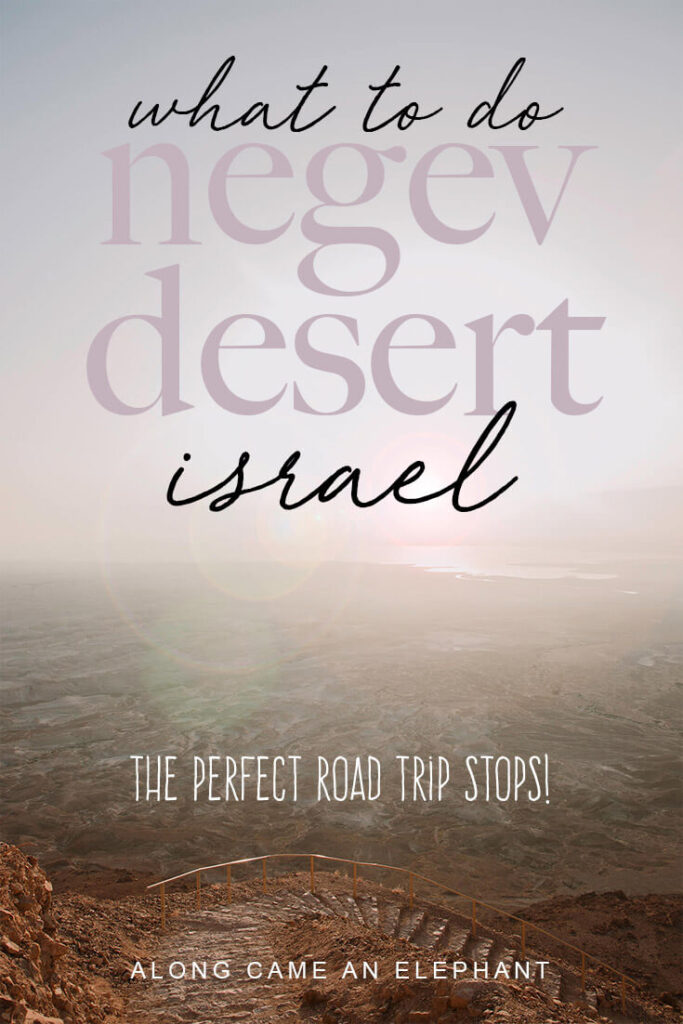
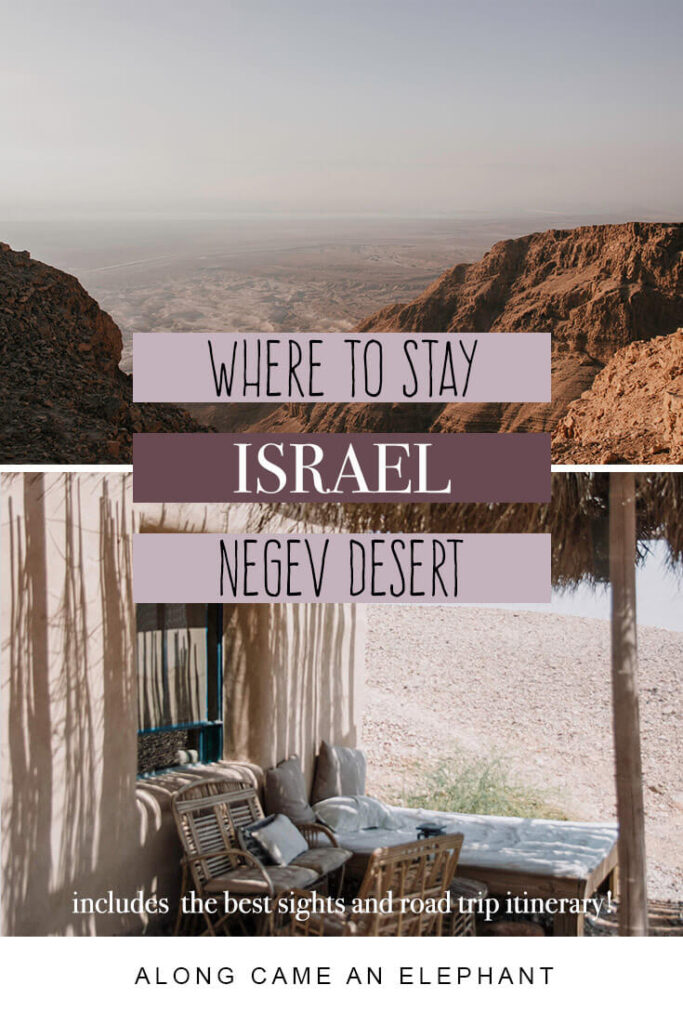
COMMENTS Expand -
ADD A COMMENT
